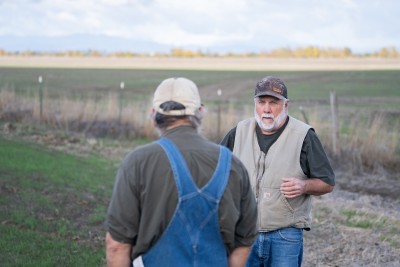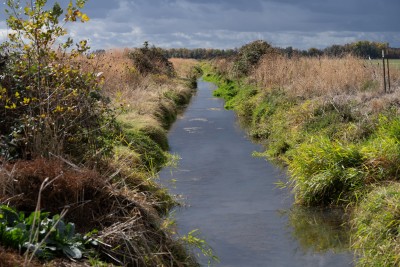By Sarah Yeoman | 5-minute read
Most folks passing through Harrisburg are usually going 65 mph on Interstate 5, probably unaware of the special farmed wetlands they’re speeding by. Here in the grass seed capital of the world, the land simultaneously supports seed crops, cattle, and sheep as well as thousands of migratory birds, raptors, elk, and more. “Before they built the interstate, it was all marsh,” says local resident Troy Jones. “But since then, it’s been cultivated, built up to be this. It’s wonderful grass seed farmland.” Oregon is one of the largest grass seed producers in the world, and the industry brings in roughly $639 million annually. Aside from being used in turf and landscaping, it’s essential in forage production supporting the state’s other largest agricultural industries, namely cattle, hay, and dairy.
The very act of draining these wetlands would drastically impact the landscape, including wildlife that depend on it. Even though the project is only meant to last 35 years, local farmers predict the soil composition will never recover.
But while residents see this land, which grows abundant with ryegrass in the summer and becomes a watery wildlife haven in the winter, as a balanced farming-wetland ecosystem, corporate entities see open fields ripe for development. Troy and neighbors founded the group Friends of Gap Road after hearing about a proposal from South Korean solar company Hanwha Q Cells to cover 1,600 acres of high-value farmland with solar panels. The project would involve the company leasing farmland from multiple owners for 35 years to create an array of solar panels stretching nearly three miles near I-5. “We’re absolutely not against solar or renewable energy. We just don’t think that taking away our exclusive farm use lands is the right thing to do,” Troy says. Instead, colocating panels in zones of low conflict – covering open parking lots, on the tops of industrial buildings, etc. – would ease the demand for renewable energy and keep farmland open and productive.
“I don’t believe that there’s any way they’ll ever separate [the soils],” Dave says. “So therefore, it will never go back to being farmland.”
Nearly 50 years ago, the Land Conservation and Development Commission (LCDC) established a process that requires that alternative locations be considered before approving certain developments such as large solar-energy generation facilities on agricultural lands. However, the Energy Facility Siting Council (EFSC) designed a workaround to allow the siting of renewable-energy projects on large tracts of high-value and other farmland without first considering alternative sites.
The land around Harrisburg, in particular, is both prime for farming and also a poor choice for solar-facility installation. As a seasonal wetland, it floods heavily in the winter, necessitating proper drainage if large amounts of electrical equipment are going to be installed. “The mud is up to your knees,” Troy says. The very act of draining these wetlands would drastically impact the landscape, including wildlife that depend on it. Even though the project is only meant to last 35 years, local farmers predict the soil composition will never recover.
Dave Rogers owns River Refuge Seed, farming on 750 acres of mostly area wetlands. The soil, he explains, is about six inches of topsoil sitting on a bed of blue clay. Installing support pilings, fencing, new roads, and other infrastructure for the solar panels will heavily mix those two different soil types. Once the project ends, it becomes the landowner’s responsibility to remediate the land. “I don’t believe that there’s any way they’ll ever separate [the soils],” Dave says. “So therefore, it will never go back to being farmland.”

Coexistence of crops and solar panels, the farmers say, is not a practical solution either. Peter Kenagy, a diversified crop farmer, says the equipment used in grass seed production is too big to operate between panels. If the companies were to space the panels out to accommodate and still get the same amount of energy production, they’d affect an area three times the size.
Arnie Canfer is a cattle rancher whose family has been in the area for 80 years. If implemented, the solar facility would sit across the road from some of his acreage. Among his concerns about the facility are fire risks, because weedy grasses under the panels would become bone-dry in the summer. “We have a lot of strong north winds that contribute to a terrible fire situation, should one get started,” he says. He speaks from experience. Two years ago, a fire in the nearby hills rapidly grew and damaged several properties. “It would completely overwhelm our local fire department. They have big, big concerns over this,” Arnie says.
If weeds aren’t managed to mitigate fire risk, they might also blow over into neighboring farms. As farming activity increases in the summer and fall, the panels will be covered with dust and need to be cleaned, increasing the risk of contamination from cleaning solutions and runoff. In addition, the local raptor population thrives off voles, and if the panels prevent them from catching their prey, “there’s … a high probability that these grounds will get infested with voles,” Peter says. Voles can be highly problematic to grass seed production by undermining the root systems and eating the seeds themselves. If they are allowed to run rampant under solar installations, they can easily spread to neighboring farms, causing damage to crops and seed production.

The transition to renewable energy doesn’t have to be at the expense of farmland. Colocating solar panels on industrial land and existing buildings makes more efficient use of space that normally sits empty. “I understand the cost ramifications of putting [solar] on warehouses, putting it on distribution centers,” Troy says. “What we need to do is look for locations for solar energy that don’t have negative long-term effects.”
There’s no need to pit two essential Oregon industries against each other, and 1000 Friends has worked to bring stakeholders together to determine best practices for siting large-scale renewable energy facilities. In 2023, legislation passed that included LCDC rulemaking for solar siting and rural industrial use, and it directed LDCD to establish criteria to identify low-conflict zones specifically for large-scale solar installations. As of February 2025, Hanwha Q Cells has yet to formally file for permits to begin solar construction.
“What we need to do is look for locations for solar energy that don’t have negative long-term effects.”
Skirting the land use system in exclusive farm use zones should ring alarm bells for Oregonians who both support expanding renewables to mitigate climate change and understand the importance of preserving the state’s essential farmland. “I think the solution is to really look long and hard at where it makes sense to put them, where they create the least impact,” Peter says. “These are not problems that can’t be solved.”
